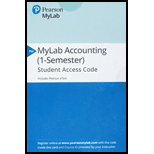
MyLab Accounting with Pearson eText -- Access Card -- for Financial Accounting
12th Edition
ISBN: 9780134727677
Author: C. William Thomas, Wendy M. Tietz, Walter T. Harrison Jr.
Publisher: PEARSON
expand_more
expand_more
format_list_bulleted
Concept explainers
Textbook Question
Chapter 2, Problem 14QC
In a double-entry accounting system,
- a. a debit entry is recorded on the left side of a T-account.
- b. half of all the accounts have a normal credit balance.
- c. liabilities, stockholders’ equity, and revenue accounts all have normal debit balances
- d. both a and b are correct
Expert Solution & Answer
Want to see the full answer?
Check out a sample textbook solution
Students have asked these similar questions
Financial accounting
Financial Accounting
can you please solve this
Chapter 2 Solutions
MyLab Accounting with Pearson eText -- Access Card -- for Financial Accounting
Ch. 2 - All of the following events at a sandwich shop are...Ch. 2 - Identify the asset from the following list of...Ch. 2 - Amounts owed to a company by its customers would...Ch. 2 - Thorpe Corporation purchases a new delivery truck...Ch. 2 - Adam Corporation issues stock to Cara Riley in...Ch. 2 - Blake Company completed a consulting job and...Ch. 2 - Prob. 7QCCh. 2 - Accounts Payable had a normal beginning balance of...Ch. 2 - Which of the following debit and credit rules is...Ch. 2 - A companys beginning Cash balance was 8,000. At...
Ch. 2 - Prob. 11QCCh. 2 - Prob. 12QCCh. 2 - Prob. 13QCCh. 2 - In a double-entry accounting system, a. a debit...Ch. 2 - Prob. 15QCCh. 2 - Prob. 16QCCh. 2 - Prob. 2.1ECCh. 2 - LO 1 (Learning Objective 1: Identify transactions)...Ch. 2 - (Learning Objective 1: Differentiate between...Ch. 2 - (Learning Objective 1: Differentiate between...Ch. 2 - (Learning Objective 2: Show the impact of...Ch. 2 - (Learning Objective 2: Show the impact of...Ch. 2 - LO 3 (Learning Objective 3: Analyze the impact of...Ch. 2 - (Learning Objective 3: Analyze the impact of...Ch. 2 - (Learning Objective 3: Analyze the impact of...Ch. 2 - (Learning Objective 4: Journalize transactions)...Ch. 2 - (Learning Objective 4: Journalize and post...Ch. 2 - (Learning Objective 4: Journalize and post...Ch. 2 - (Learning Objective 4: Journalize transactions)...Ch. 2 - Prob. 2.13SCh. 2 - (Learning Objective 5: Use a trial balance)...Ch. 2 - Prob. 2.15SCh. 2 - (Learning Objectives 1, 2, 3, 4, 5: Define...Ch. 2 - Group A LO 1, 2, 4 (Learning Objectives 1, 2, 4:...Ch. 2 - LO 3 (Learning Objective 3: Analyze the impact of...Ch. 2 - (Learning Objective 3: Analyze the impact of...Ch. 2 - (Learning Objective 2: Show the impact of business...Ch. 2 - (Learning Objective 4: Journalize transactions in...Ch. 2 - (Learning Objectives 4, 5: Post journal entries...Ch. 2 - Prob. 2.23AECh. 2 - (Learning Objective 5: Construct and use a trial...Ch. 2 - (Learning Objective 5: Construct and use a trial...Ch. 2 - (Learning Objective 5: Solve for cash and...Ch. 2 - (Learning Objectives 1, 2, 4: Identify...Ch. 2 - (Learning Objective 3: Analyze the impact of...Ch. 2 - (Learning Objective 3: Analyze the impact of...Ch. 2 - (Learning Objective 2: Show the impact of business...Ch. 2 - LO 4 (Learning Objective 4: Journalize...Ch. 2 - Prob. 2.32BECh. 2 - (Learning Objective 4: Journalize entries and...Ch. 2 - (Learning Objective 5: Construct and use a trial...Ch. 2 - Prob. 2.35BECh. 2 - LO 5 (Learning Objective 5: Solve for cash and...Ch. 2 - (Learning Objectives 4, 5; Journalize and poet...Ch. 2 - Which of the following is an asset? a. Common...Ch. 2 - Prob. 2.39QCh. 2 - The journal entry to record the acquisition of...Ch. 2 - The journal entry to record the purchase of...Ch. 2 - If the credit to record the purchase of supplies...Ch. 2 - The journal entry to record a payment on account...Ch. 2 - If the credit to record the payment of an account...Ch. 2 - Which statement is false? a. A trial balance lists...Ch. 2 - If a corporation purchases a delivery van for...Ch. 2 - Prob. 2.47QCh. 2 - Prob. 2.48QCh. 2 - Prob. 2.49QCh. 2 - Prob. 2.50QCh. 2 - Receiving cash from a customer on account will a....Ch. 2 - Prob. 2.52QCh. 2 - Purchasing a building for 115,000 by paying cash...Ch. 2 - Prob. 2.54QCh. 2 - Prob. 2.55QCh. 2 - Prob. 2.56QCh. 2 - Prob. 2.57QCh. 2 - (Learning Objective 5: Construct and use a trial...Ch. 2 - LO 2,3 (Learning Objectives 2, 3: Analyze the...Ch. 2 - (Learning Objective 4: Journalize transactions and...Ch. 2 - LO 4,5 (Learning Objectives 4, 5: Journalize and...Ch. 2 - Prob. 2.62APCh. 2 - Prob. 2.63BPCh. 2 - Prob. 2.64BPCh. 2 - Prob. 2.65BPCh. 2 - (Learning Objectives 4, 5: Journalize and post...Ch. 2 - (Learning Objectives 3, 5: Analyze the impact of...Ch. 2 - (Learning Objective 5: Analyzing accounts) The...Ch. 2 - Prob. 2.69CEPCh. 2 - Prob. 2.70CEPCh. 2 - (Learning Objectives 2, 3, 4: Analyze the impact...Ch. 2 - Prob. 2.72SCCh. 2 - Prob. 2.73DCCh. 2 - Prob. 2.74DCCh. 2 - Prob. 2.75EICCh. 2 - Prob. 2.76EICCh. 2 - Prob. 1FFCh. 2 - Prob. 1FA
Knowledge Booster
Learn more about
Need a deep-dive on the concept behind this application? Look no further. Learn more about this topic, accounting and related others by exploring similar questions and additional content below.Similar questions
arrow_back_ios
SEE MORE QUESTIONS
arrow_forward_ios
Recommended textbooks for you
- Principles of Accounting Volume 1AccountingISBN:9781947172685Author:OpenStaxPublisher:OpenStax College
 Financial Accounting: The Impact on Decision Make...AccountingISBN:9781305654174Author:Gary A. Porter, Curtis L. NortonPublisher:Cengage Learning
Financial Accounting: The Impact on Decision Make...AccountingISBN:9781305654174Author:Gary A. Porter, Curtis L. NortonPublisher:Cengage Learning College Accounting, Chapters 1-27AccountingISBN:9781337794756Author:HEINTZ, James A.Publisher:Cengage Learning,
College Accounting, Chapters 1-27AccountingISBN:9781337794756Author:HEINTZ, James A.Publisher:Cengage Learning,

Principles of Accounting Volume 1
Accounting
ISBN:9781947172685
Author:OpenStax
Publisher:OpenStax College

Financial Accounting: The Impact on Decision Make...
Accounting
ISBN:9781305654174
Author:Gary A. Porter, Curtis L. Norton
Publisher:Cengage Learning

College Accounting, Chapters 1-27
Accounting
ISBN:9781337794756
Author:HEINTZ, James A.
Publisher:Cengage Learning,
The ACCOUNTING EQUATION For BEGINNERS; Author: Accounting Stuff;https://www.youtube.com/watch?v=56xscQ4viWE;License: Standard Youtube License